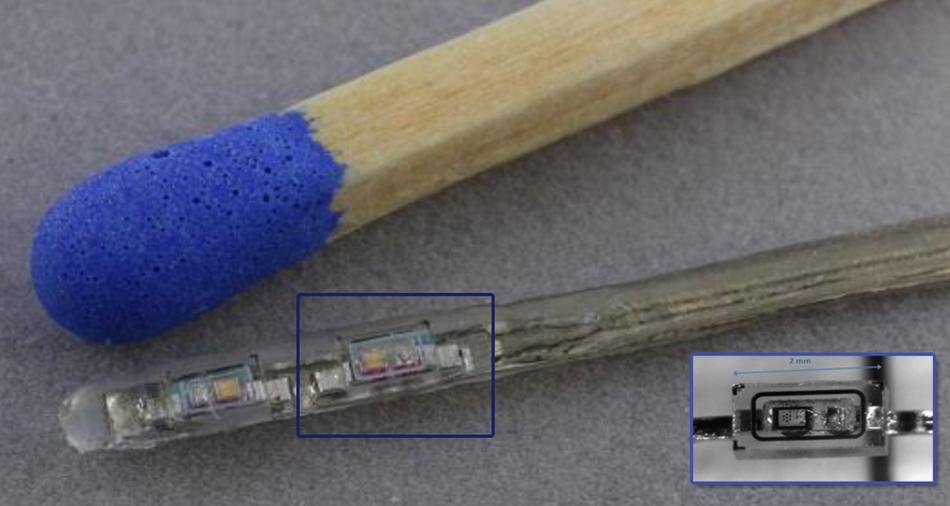
Cochlear implants are electronic prosthetic devices used in adults and children with sensory neural hearing loss, who are not benefited by the use of conventional hearing aids. They bypass the functions of damaged hair cells inside the inner ear and directly stimulates the spiral ganglion of the cochlear nerve (nerve of hearing).
Optoacoustic stimulation of cochlea
The electrodes used in conventional cochlear implants stimulate the neurons of spiral ganglia / cochlear nerve by electrical signals. The main limitation with electrical stimulation is the narrow focusing of the signals in the desired region, mainly because of the cochlear geometry. As the cochlea has a tonotopic structure, targeting one specific tone usually triggers others as well.
Recent studies involving sciatic nerve, cavernous nerve and embryo hearts have shown that neurons can be excited by means of other methods also, like thermal, mechanical and optical stimulation.

Based on these findings a group of researchers from Germany, Austria, and Switzerland funded by the EU, has come up with a prototype optoacoustic cochlear implant (Project ACTion – ACTive Implant for Optoacoustic Sound Enhancement). The special electrode emits a series of laser pulses that can generate auditory signals in cochlear hair cells by a mechanism called optoacoustic stimulation.
The electrode arrays used in this prototype cochlear implant has vertical-cavity surface-emitting lasers (VCSEL), which pulsate light in the infra-red spectrum of 1.4 to 1.9 microns for nanoseconds.
The electrode is inserted into cochlea by a standard cochlear implantation technique. When the electrode emits light, a small fraction of the intracochlear liquids will get expanded due to the heat generated. This rapid expansion of intracochlear fluid generates a traveling sound wave inside the scala media (duct) of cochlea resulting in an electrical impulse in the auditory nerve.
When the stimuli generated in guinea pigs via optoacoustic stimulation (laser electrodes) was compared with regular electro-acoustic stimulation (conventional electrodes), the generated nerve signals were matching in form and amplitude.
Pros and Cons of ACTion’s optoacoustic cochlear implant
The optoacoustic stimulation is similar to natural hearing, a traveling sound wave being generated by the stapes pushing against the oval window at the base of the cochlea.
Many cochlear implant recipients have functional residual inner hair cells which can allow them to hear low-frequency natural sounds. Hence the recent development in conventional cochlear implants is the use of ‘electro-acoustic stimulation’ or ‘EAS’ which uses a hearing aid for amplification of the natural low-frequency sounds and a cochlear implant for the high-frequency sounds. EAS can lead to better sound quality and speech understanding.
But in many cases of conventional cochlear implants, it’s observed that due to repeated electrical stimulation these hair cells eventually get damaged. Opto-acoustic stimulation can avoid such damages to hair cells. Also, the external hearing aid is associated with a canal occlusion effect, which can result in noncompliance to wearing by the recipient.
Though it all sounds interesting, there are various drawbacks associated with the prototype.
Unlike conventional cochlear implants which use electric currents and directly stimulates auditory nerve fibers, ACTion’s optoacoustic cochlear implant rely on functional hair cells to convert sound waves to electric signals. Hence it can be used only in those patients with a good number of residual functional hair cells.
There are many design challenges for the optoacoustic cochlear implant like the issue with power consumption and size of the device. Currently, the whole device has the size of a large laptop adapter. But the researchers are optimistic about miniaturization of the implant before commercialization.
Is it available for implantation?
So far, only a prototype of the ACTion’s cochlear electrode is available now and the studies are restricted only to deaf guinea pigs. Human trials are still pending and it will take a long time ahead to get it approved.
Various other parallel researches are also going on around the world in using light to transmit auditory signals. Tobias Moser’s team at the University of Göttingen in Germany and Ed Boyden at the Massachusetts Institute of Technology aims at genetically altering hair cells so that they can respond to light impulses. Gentiana Wenzel, from the University of Saarland in Homburg, Germany, is currently experimenting with using a green laser coded for sound frequencies to activate the inner ear.
The U.S. National Institute on Deafness and Other Communication Disorders has recently received funds from U.S military, for research in laser-related implants.
References
- ACTION project
- Kallweit, N. et al. Optoacoustic effect is responsible for laser-induced cochlear responses. Sci. Rep. 6, 28141; doi: 10.1038/srep28141 (2016)